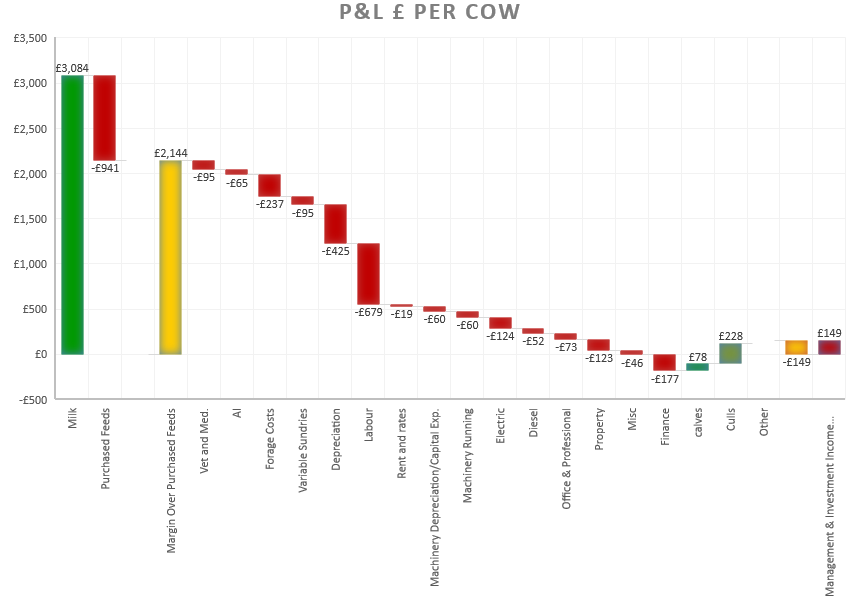
If dairy income was a sponge cake, how big a slice would you end up with after everybody else has had a slice?
This time last year it was a nice size cake, but the slices that the costs took were also pretty big. This year the cake is an awful lot smaller, but the costs are still wanting a big slice. This isn’t leaving much on the plate for the farm’s profit position (Management & Investment Income – MII).
Who’s geting a slice of the action?
The waterfall chart below shows a typical dairy farm currently on 36.5ppl of milk income (Green bar). As costs bite deep into the dairy cake’s spongy centre, it’s not long before the whole cake is gone! This leaves the farmer to be sustained by the cup cakes that were made with the bit of left over mixture (calves and culls) to get back to black. Economics dictates that a dairy enterprise cannot survive on cup cakes alone!

We’re going to need a bigger cake!
With so many getting their jaws around the cake, we either need a bigger cake or we need stick it in a tin and put the lid on. Or do a bit of both.
The ingredients to building a bigger cake could be:
- Maximise milk components – Add more fat and protein.
- Reduce somatic cells counts – additives may be required.
- Check ration’s physical and chemical balance – Preheat the oven (rumen) over the dry period then keep at a constant temp throughout the lactation.
- Utilised Dry Matter – Don’t waste any mixture .
- Feed space, light and cow comfort – Use a bit enough tin .
- Replacement heifers – Whip them up during preparation so they rise to the challenge.
- Plan and replan – It’s more efficient to follow a recipe, knowing what ingredients you have and keeping an eye on the time.
Is cake taking too much of the cake?
Purchased feed is just about the biggest chunk of cake. Some of this cost is undoubtedly an investment and helps build a bigger cake. However, we know from looking at the Kingshay Milk Map that too many farms are sat in the bottom half (check out the tool here). This means that for the amount of purchased feed used, it just isn’t making that cake rise (milk income). Adding a bit of sodium bicarb might help, but something is wrong to be there. Some ingredients or something in the preparation just isn’t working as it should.
Many farms tend use high fibre HDF cakes. This is probably ok if you are making a dense little carrot cake, but if you want a big sponge, you are going to need more starch and sugar. Forage is your main source of fibre and has huge potential to supply large amounts of the starch and sugar too (weather allowing). Whilst achieving more Milk From Forage is a really important ambition, it is not guaranteed to leave you with a big slice of the cake. It needs to be carefully planned into the recipe.
Slice and dice
Things that generate more return should be getting a bigger slice of the cake. I know farmers are looking at all their expenditure very carefully.
Recent interest rate rises have not been helpful. For a business like dairy that typically makes a 2-4% RoCE (before interest), paying out 5-8% on interest hurts.
Star Baker
As said in previous articles, the first rule of Dairy Club is to challenge. The star bakers out there will be the ones prepared to change the recipe, challenging every ingredient on its ability to generate cash.
With fewer and fewer dairy farmers with every month that goes by, once all the cheese-cake that is currently in store is gone, then the supply chain will be needing those that remain to make one hell of a showstopper.
Please check out the resources on the Dairy Club site. The Club is open for dairy farmers to join for free.
Please use the form below for any comments or suggestions (only constructive messages please. If you are looking to be negative, please go back to Twitter!)
[wpforms id=”371″]
